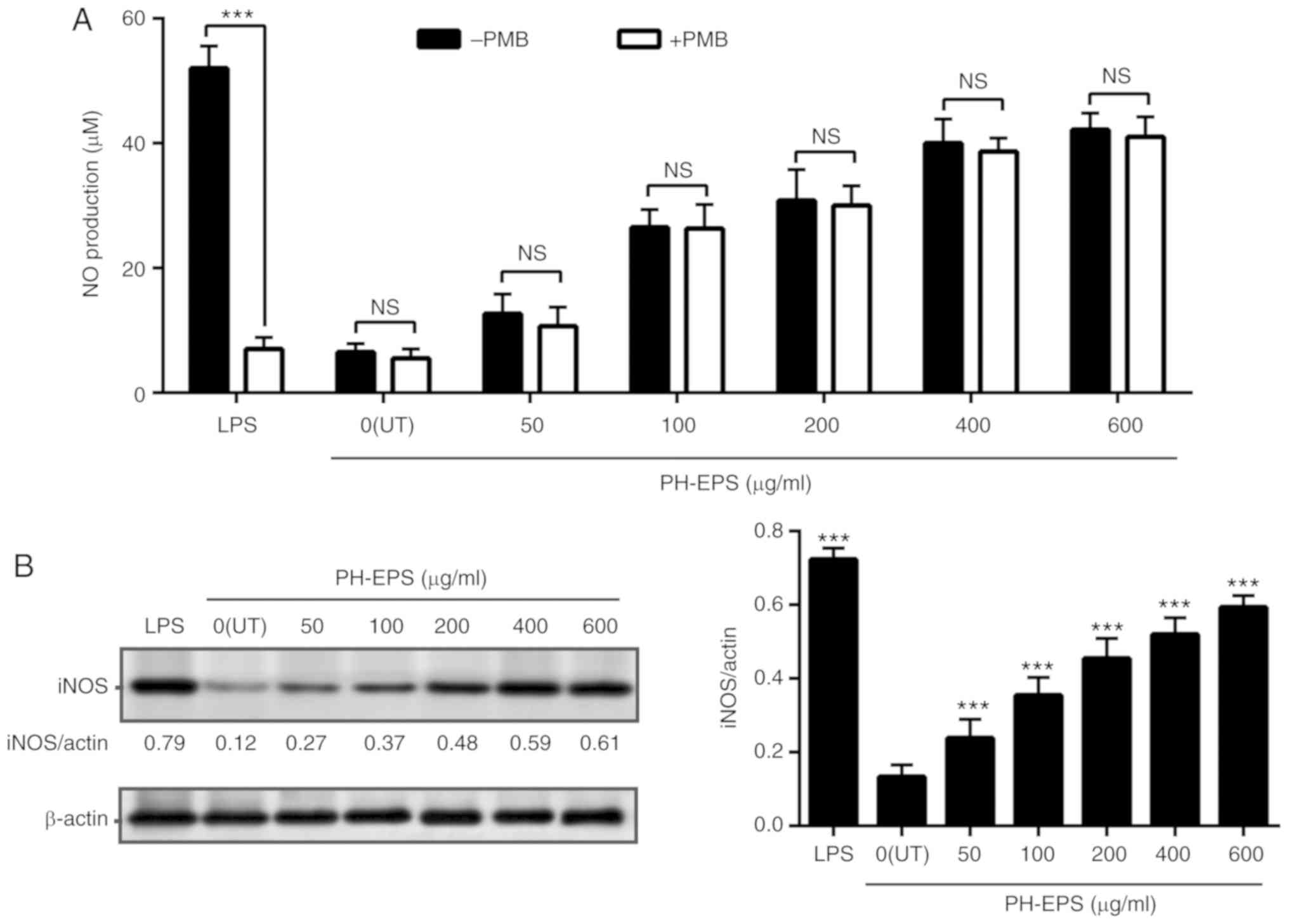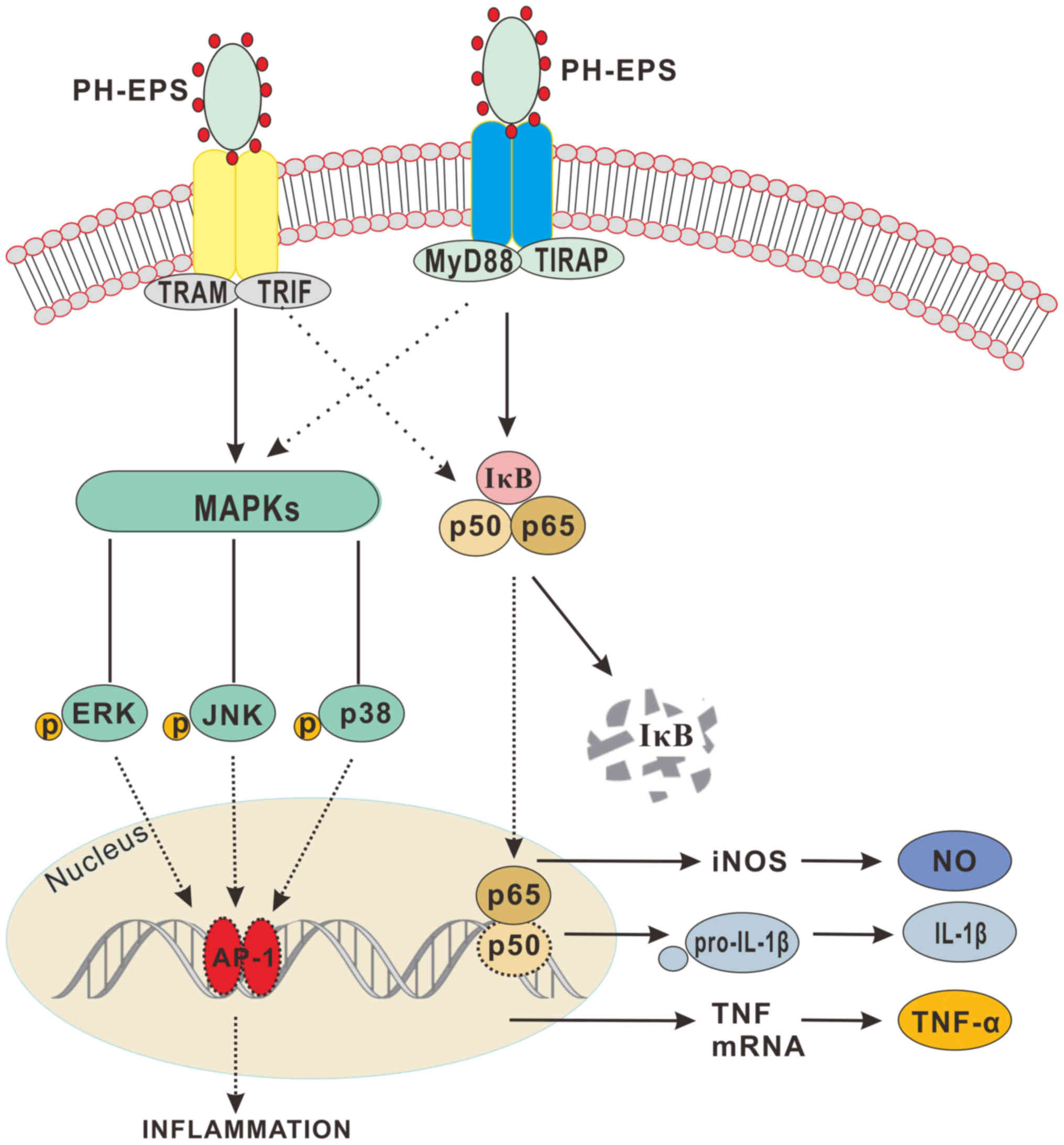|
1
|
Gordon S and Plüddemann A: Tissue
macrophages: Heterogeneity and functions. BMC Biol. 15:532017.
View Article : Google Scholar : PubMed/NCBI
|
|
2
|
Varin A and Gordon S: Alternative
activation of macrophages: Immune function and cellular biology.
Immunobiology. 214:630–641. 2009. View Article : Google Scholar : PubMed/NCBI
|
|
3
|
Navegantes KC, de Souza Gomes R, Pereira
PAT, Czaikoski PG, Azevedo CHM and Monteiro MC: Immune modulation
of some autoimmune diseases: The critical role of macrophages and
neutrophils in the innate and adaptive immunity. J Transl Med.
15:362017. View Article : Google Scholar : PubMed/NCBI
|
|
4
|
Mosser DM and Edwards JP: Exploring the
full spectrum of macrophage activation. Nat Rev Immunol. 8:958–969.
2008. View
Article : Google Scholar : PubMed/NCBI
|
|
5
|
Kim HS, Kim YJ, Lee HK, Ryu HS, Kim JS,
Yoon MJ, Kang JS, Hong JT, Kim Y and Han SB: Activation of
macrophages by polysaccharide isolated from Paecilomyces cicadae
through toll-like receptor 4. Food Chem Toxicol. 50:3190–3197.
2012. View Article : Google Scholar : PubMed/NCBI
|
|
6
|
Li J, Qian W, Xu Y, Chen G, Wang G, Nie S,
Shen B, Zhao Z, Liu C and Chen K: Activation of RAW 264.7 cells by
a polysaccharide isolated from Antarctic bacterium Pseudoaltermonas
sp. S-5. Carbohydr Polym. 130:97–103. 2015. View Article : Google Scholar : PubMed/NCBI
|
|
7
|
Laplante P, Amireault P, Subang R, Dieudé
M, Levine JS and Rauch J: Interaction of β2-glycoprotein I with
lipopolysaccharide leads to Toll-like receptor 4 (TLR4)-dependent
activation of macrophages. J Biol Chem. 286:42494–42503. 2011.
View Article : Google Scholar : PubMed/NCBI
|
|
8
|
Chen LF and Greene WC: Regulation of
distinct biological activities of the NF-kappaB transcription
factor complex by acetylation. J Mol Med (Berl). 81:549–557. 2003.
View Article : Google Scholar : PubMed/NCBI
|
|
9
|
Hayden MS and Ghosh S: Signaling to
NF-kappaB. Genes Dev. 18:2195–2224. 2004. View Article : Google Scholar : PubMed/NCBI
|
|
10
|
Baldwin AS Jr: The NF-kappa B and I kappa
B proteins: New discoveries and insights. Annu Rev Immunol.
14:649–683. 1996. View Article : Google Scholar : PubMed/NCBI
|
|
11
|
Lee JS, Kwon DS, Lee KR, Park JM, Ha SJ
and Hong EK: Mechanism of macrophage activation induced by
polysaccharide from Cordyceps militaris culture broth. Carbohydr
Polym. 120:29–37. 2015. View Article : Google Scholar : PubMed/NCBI
|
|
12
|
Ayoub SS, Botting RM, Joshi AN, Seed MP
and Colville-Nash PR: Activation of macrophage peroxisome
proliferator-activated receptor-gamma by diclofenac results in the
induction of cyclooxygenase-2 protein and the synthesis of
anti-inflammatory cytokines. Mol Cell Biochem. 327:101–110. 2009.
View Article : Google Scholar : PubMed/NCBI
|
|
13
|
Skeen MJ, Miller MA, Shinnick TM and
Ziegler HK: Regulation of murine macrophage IL-12 production.
Activation of macrophages in vivo, restimulation in vitro, and
modulation by other cytokines. J Immunol. 156:1196–1206.
1996.PubMed/NCBI
|
|
14
|
Takeuchi O and Akira S: Toll-like
receptors; their physiological role and signal transduction system.
Int Immunopharmacol. 1:625–635. 2001. View Article : Google Scholar : PubMed/NCBI
|
|
15
|
Wang G, Zhu L, Yu B and Chen K, Liu B, Liu
J, Qin G, Liu C, Liu H and Chen K: Exopolysaccharide from
Trichoderma pseudokoningii induces macrophage activation. Carbohydr
Polym. 149:112–120. 2016. View Article : Google Scholar : PubMed/NCBI
|
|
16
|
Paynich ML, Jones-Burrage SE and Knight
KL: Exopolysaccharide from bacillus subtilis induces
anti-inflammatory M2 macrophages that prevent T cell-mediated
disease. J Immunol. 198:2689–2698. 2017. View Article : Google Scholar : PubMed/NCBI
|
|
17
|
Zhu Y, Wang C, Jia S, Wang B, Zhou K, Chen
S, Yang Y and Liu S: Purification, characterization and antioxidant
activity of the exopolysaccharide from Weissella cibaria SJ14
isolated from Sichuan paocai. Int J Biol Macromol. 115:820–828.
2018. View Article : Google Scholar : PubMed/NCBI
|
|
18
|
Yamac M, Kanbak G, Zeytinoglu M,
Bayramoglu G, Senturk H and Uyanoglu M: Hypoglycemic effect of
Lentinus strigosus (Schwein.) Fr. crude exopolysaccharide in
streptozotocin-induced diabetic rats. J Med Food. 11:513–517. 2008.
View Article : Google Scholar : PubMed/NCBI
|
|
19
|
Wang YX, Hu HY, Yang W, et al: The in
vitro anti-HSV-1 action of an EPS extract made from Paecilomyces
lilacinus isolated from mangr soil. J Pathog Biol (China). 12:5–9.
2014.(In Chinese).
|
|
20
|
Li GJ, Chang C, Ge TT, et al: Anti-HSV-1
activity in vitro of extracellular polysaccharides from
Paecilomyces Lilacinuson isolated from mangrove. Shanxi Med J
(China). 46:123–126. 2017.(In Chinese).
|
|
21
|
Hu HY, Wang HM, Lin YZ, Chang CH, Yang W
and Wang YX: Effects of extracellular polysaccharides from
Paecilomyces Lilacinuson on function of mouse bone marrow-derived
dendritic cells. Chin J Immunol. 33:212–216. 2017.(In Chinese).
|
|
22
|
Peixoto E, Oliveira JC, Antas PR and Borba
CM: In-vitro study of the host-parasite interactions between mouse
macrophages and the opportunistic fungus Paecilomyces lilacinus.
Ann Trop Med Parasitol. 104:529–534. 2010. View Article : Google Scholar : PubMed/NCBI
|
|
23
|
Huang FY, Huang FR, Chen B, Liu Q, Wang H,
Zhou SL, Zhao HG, Huang YH, Lin YY and Tan GH: Microencapsulation
of tumor lysates and live cell engineering with MIP-3α as an
effective vaccine. Biomaterials. 53:554–565. 2015. View Article : Google Scholar : PubMed/NCBI
|
|
24
|
Liang TW and Wang SL: Recent advances in
exopolysaccharides from Paenibacillus spp.: Production, isolation,
structure, and bioactivities. Mar Drugs. 13:1847–1863. 2015.
View Article : Google Scholar : PubMed/NCBI
|
|
25
|
Liu J, Wang X, Pu H, Liu S, Kan J and Jin
C: Recent advances in endophytic exopolysaccharides: Production,
structural characterization, physiological role and biological
activity. Carbohydr Polym. 157:1113–1124. 2017. View Article : Google Scholar : PubMed/NCBI
|
|
26
|
Moscovici M: Present and future medical
applications of microbial exopolysaccharides. Front Microbiol.
6:10122015. View Article : Google Scholar : PubMed/NCBI
|
|
27
|
Li P and Wang F: Polysaccharides:
Candidates of promising vaccine adjuvants. Drug Discov Ther.
9:88–93. 2015. View Article : Google Scholar : PubMed/NCBI
|
|
28
|
Glucksam-Galnoy Y, Sananes R, Silberstein
N, Krief P, Kravchenko VV, Meijler MM and Zor T: The bacterial
quorum-sensing signal molecule N-3-oxo- dodecanoyl-L-homoserine
lactone reciprocally modulates pro- and anti-inflammatory cytokines
in activated macrophages. J Immunol. 191:337–344. 2013. View Article : Google Scholar : PubMed/NCBI
|
|
29
|
Kleinert H, Schwarz PM and Forstermann U:
Regulation of the expression of inducible nitric oxide synthase.
Biol Chem. 384:1343–1364. 2003. View Article : Google Scholar : PubMed/NCBI
|
|
30
|
Nworu CS, Ihim SA, Okoye FB, Esimone CO,
Adikwu MU and Akah PA: Immunomodulatory and immunorestorative
activities of β-D-glucan-rich extract and polysaccharide fraction
of mushroom, Pleurutus tuberregium. Pharm Biol. 53:1555–1566. 2015.
View Article : Google Scholar : PubMed/NCBI
|
|
31
|
Gupta P and Barthwal MK: IL-1 β genesis:
The art of regulating the regulator. Cell Mol Immunol. 15:998–1000.
2018. View Article : Google Scholar : PubMed/NCBI
|
|
32
|
Dinarello CA: Immunological and
inflammatory functions of the interleukin-1 family. Annu Rev
Immunol. 27:519–550. 2009. View Article : Google Scholar : PubMed/NCBI
|
|
33
|
Yan Q, Chen X, Gong H, Qiu P, Xiao X, Dang
S, Hong A and Ma Y: Delivery of a TNF-α-derived peptide by
nanoparticles enhances its antitumor activity by inducing
cell-cycle arrest and caspase-dependent apoptosis. FASEB J.
30:fj201800377R2018.(Epub ahead of print).
|
|
34
|
Bergers G and Benjamin LE: Tumorigenesis
and the angiogenic switch. Nat Rev Cancer. 3:401–410. 2003.
View Article : Google Scholar : PubMed/NCBI
|
|
35
|
Henneke P and Golenbock DT: Phagocytosis,
innate immunity, and host-pathogen specificity. J Exp Med. 199:1–4.
2004. View Article : Google Scholar : PubMed/NCBI
|
|
36
|
Hatada EN, Krappmann D and Scheidereit C:
NF-kappaB and the innate immune response. Curr Opin Immunol.
12:52–58. 2000. View Article : Google Scholar : PubMed/NCBI
|
|
37
|
Ruimi N, Rwashdeh H, Wasser S, Konkimalla
B, Efferth T, Borgatti M, Gambari R and Mahajna J: Daedalea gibbosa
substances inhibit LPS-induced expression of iNOS by suppression of
NF-kappaB and MAPK activities in RAW 264.7 macrophage cells. Int J
Mol Med. 25:421–432. 2010.PubMed/NCBI
|
|
38
|
Johnson GL and Lapadat R:
Mitogen-activated protein kinase pathways mediated by ERK, JNK, and
p38 protein kinases. Science. 298:1911–1912. 2002. View Article : Google Scholar : PubMed/NCBI
|
|
39
|
Jones E, Adcock IM, Ahmed BY and Punchard
NA: Modulation of LPS stimulated NF-kappaB mediated Nitric Oxide
production by PKCepsilon and JAK2 in RAW macrophages. J Inflamm
(Lond). 4:232007. View Article : Google Scholar : PubMed/NCBI
|
|
40
|
Yoon YD, Kang JS, Han SB, Park SK, Lee HS,
Kang JS and Kim HM: Activation of mitogen-activated protein kinases
and AP-1 by polysaccharide isolated from the radix of Platycodon
grandiflorum in RAW 264.7 cells. Int Immunopharmacol. 4:1477–1487.
2004. View Article : Google Scholar : PubMed/NCBI
|
|
41
|
Park JM, Kunieda T and Kubo T: The
activity of Mblk-1, a mushroom body-selective transcription factor
from the honeybee, is modulated by the ras/MAPK pathway. J Biol
Chem. 278:18689–18694. 2003. View Article : Google Scholar : PubMed/NCBI
|
|
42
|
Agustinho DP, de Oliveira MA, Tavares AH,
Derengowski L, Stolz V, Guilhelmelli F, Mortari MR, Kuchler K and
Silva-Pereira I: Dectin-1 is required for miR155 upregulation in
murine macrophages in response to Candida albicans. Virulence.
8:41–52. 2017. View Article : Google Scholar : PubMed/NCBI
|
|
43
|
Cohen N, Stolarsky-Bennun M, Amir-Kroll H,
Margalit R, Nussbaum G, Cohen-Sfady M, Pevsner-Fischer M, Fridkin
M, Bercovier H, Eisenbach L, et al: Pneumococcal capsular
polysaccharide is immunogenic when present on the surface of
macrophages and dendritic cells: TLR4 signaling induced by a
conjugate vaccine or by lipopolysaccharide is conducive. J Immunol.
180:2409–2418. 2008. View Article : Google Scholar : PubMed/NCBI
|
|
44
|
Herre J, Gordon S and Brown GD: Dectin-1
and its role in the recognition of beta-glucans by macrophages. Mol
Immunol. 40:869–876. 2004. View Article : Google Scholar : PubMed/NCBI
|
|
45
|
Le Cabec V, Carreno S, Moisand A, Bordier
C and Maridonneau-Parini I: Complement receptor 3 (CD11b/CD18)
mediates type I and type II phagocytosis during nonopsonic and
opsonic phagocytosis, respectively. J Immunol. 169:2003–2009. 2002.
View Article : Google Scholar : PubMed/NCBI
|






















